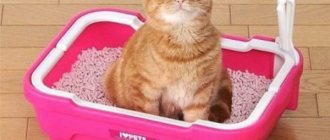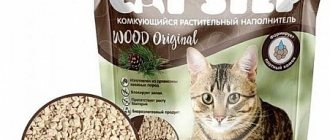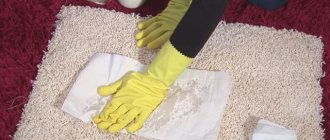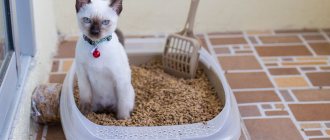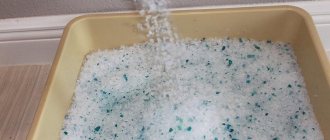Pets are our friends who cheer us up and help us relax after work. But caring for them can be difficult, especially in an apartment, when the animal does not go outside or prefers to do all its business in the house. Cat litter helps with hygiene issues, but the area may still smell unpleasant. And this is not what the owners of furry four-legged animals want to see. Therefore, today we will look at how to get rid of the smell of cat litter and keep your home clean if you have pets.
Causes of odor
Of course, the toilet itself can no longer smell pleasant. But some factors aggravate the problem, causing an unpleasant odor in the room. What reasons lead to this result?
1. The tray does not change for a long time.
2. Cleaning the tray is superficial; dirty particles remain at the bottom.
3. The animal goes to the toilet past the tray or spreads the remains with its paws.
4. The filler does not cope with odor removal.
Also, the cause of the pungent odor may be the animal’s poor diet. In any case, we know what to do.
How to remove the smell of cat urine
Proven folk methods and effective professional remedies will help you.
Traditional methods
If the “trouble” takes you by surprise, you do not have time to purchase a special remedy for cat odor - use homemade remedies. Those who do not want to buy expensive detergents can also do the same.
Important! Test the chosen method on a test area so as not to spoil the entire item or surface. Non-standard reactions of surfaces to the method you choose are possible.
Folk remedies for eliminating unpleasant cat odor:
- Mineral water with salt;
- Potassium permanganate;
- Vinegar;
- Lemon juice;
- Hydrogen peroxide and soda;
- Iodine;
- Glycerin soap;
- Laundry soap;
- Vodka.
Below is a detailed description of each method.
Potassium permangantsovka
Manganese breaks down ammonia crystals, eliminating odor. When using it, keep in mind that it may stain the surface. Therefore, use it only on non-absorbent surfaces (floors, countertops). Wipe the mark area with a saturated crimson solution and wash off the potassium permanganate with water. You need to make sure that all the crystals are dissolved - they can leave stains on surfaces.
Vinegar
Vinegar, diluted in water in a ratio of 1:2, does an excellent job of removing odors and removing stains on fabric surfaces and carpets. The vinegar solution is poured into a spray bottle and the areas of “embarrassment” are sprayed. After this, you need to thoroughly wash the treatment areas. Clothes treated in this way are washed.
Lemon juice
Freshly squeezed juice of one lemon is mixed with a glass of water. Wipe the marked area with this solution. There is no need to rinse off - the remaining smell will scare away the cat.
Hydrogen peroxide and soda
An effective stain remover for upholstery and carpets.
- Method : Sprinkle soda on the stain in a thick layer. It is filled with peroxide on top. Do not be alarmed, during the chemical reaction a strong smell of ammonia is released - it disappears. The mixture is left overnight, and in the morning the residue is removed with a damp, soapy cloth.
- Method : 2 tablespoons of soda mixed with 15 g. peroxide and dissolve in liquid soap. Treat the stain with the resulting mixture, then rinse with warm water.
Iodine
Suitable for cleaning textiles and dark carpets. 20 drops of iodine are diluted in a liter of water. The mark is treated with this solution. After a few hours, the treatment area is washed with warm water. The product cannot be used on light-colored items.
Glycerin soap
Glycerin successfully fights urea. The product is suitable for cleaning furniture upholstery. Moisten a soap bar with water and thoroughly wipe the stained surface with it. Then the area is treated with a coarse bristle brush, rinsed with warm water and dried thoroughly.
Laundry soap
The soap is grated and poured with a small amount of warm water. This paste is applied to the stain and thoroughly rubbed into upholstery, shoes and textiles. Wait 30 minutes and wash off with warm water.
Vodka
It is not particularly effective as a stain and odor remover, but its main role in this case is to create an unpleasant odor for the cat. There are substances in vodka that the cat really doesn’t like, so you don’t have to worry about him wanting to leave his “mark” here again. Use undiluted vodka to treat stains on the floor, furniture and carpets. The disadvantage of this method is that the smell of alcohol takes a long time to dissipate.
Sparkling water with salt
The method is suitable for mattresses and carpets. The surface is poured with soda and sprinkled generously with salt. Wash off after a few hours with warm water.
Fighting the smell
Don't be too quick to scold your cat: caring for pets indoors really requires attention. But everything is simpler than you think. And we tell you how to get rid of the smell of cat litter and maintain cleanliness.
Daily change of filler
The advice may seem simple, but daily removal of used filler will prevent the accumulation of dirt, which provokes the spread of an unpleasant odor. You can do this in the morning or evening at approximately the same time. If the animal went to the toilet in front of you and there is an opportunity to do the cleaning immediately, do not wait for the scheduled time and eliminate the “cat’s business” immediately after appearing.
General cleaning
If cleaning once a day during the week is enough, on the weekends you should devote about 30 minutes to general cleaning. Here, replacing the old filler with fresh one is not enough: your task is to completely remove all the contents and thoroughly wash the tray. You can use a soap solution, but after cleaning it is thoroughly washed off, the tray is dried, and after 5-10 minutes it is filled with fresh granules or sawdust.
Causes of persistent unpleasant odor
It is clear that without understanding the reasons why cat urine has such a persistent and strong odor, it is completely useless to think about how to remove the cat odor. You don’t need to be a professional chemist to figure it out and then find methods to eliminate the problem.
Photo from the site: 29palms.ru
- Uric or uric acid is our main “enemy”, which is the most difficult to fight. This substance dries out very quickly and crystallizes, after which it is practically insoluble either in water or in most household cleaning products. But it dissolves well in acidic environments, which is why vinegar, citric acid, and alkali solutions are called effective.
- The second component of urine is urochrome, a substance that gives the liquid a persistent yellow tint that leaves stains. It washes off quite well with any cleaning solution, but best of all with glycerin soap.
- Urea gives the cat’s “surprises” stickiness; it is easily washed off with plain water, and this definitely won’t cause any problems.
Uric acid “knows how” to camouflage itself very well. That is, when cleaning up traces of a “crime,” you can mask the unpleasant odor with aromatic fragrances, but after they dissipate and moisture gets on the acid crystals, they will “smell” even more strongly. It is more difficult to remove the smell of urine from soft surfaces, for example, from furniture, but easier to remove from the floor. The main thing is that urine does not seep through or be absorbed into the floor covering, otherwise it will have to be replaced completely or at least partially.
Choosing a cat litter box
Odor retention also depends on the type of tray. What types are there and what to choose?
1. Regular trays, which can be sold together with a grill for ease of cleaning. Cats have no problem entering such a toilet, but they can scoop some of the dirty litter onto the floor.
2. Closed, in the form of houses. These retain odor better and prevent granules from scattering. But some cats are afraid to go into closed houses.
3. Dry toilets for cats are a whole structure with cartridges, reusable granules, and other elements. The disadvantages are the dimensions and high cost.
Household chemicals
You can remove urinary stones using various means that are specifically designed for treating cat litter boxes. You can also use household products to clean toilets. You can get rid of urinary stones using baking soda and regular laundry soap.
If the coating is thick enough and difficult to wash off, then you just need to apply a detergent (for example, Domestos) to the entire surface of the tray and leave for 2-3 hours. After this, you need to rinse the plastic tray well under running water and dry it.
Types of fillers
The result also depends on the choice of filler: some quickly become unusable and crumble, others maintain cleanliness for a long time. Which cat litter to choose?
clumping
This composition includes attapulgite, vermiculite and zeolite. The advantage is that after getting wet, the mass hardens - ready-made lumps are easy to remove with a scoop. Available in both versions: with and without flavoring.
Silica gel
These granules are your best friends when cleaning your cat's litter box. The components absorb liquid, but remain dry and prevent the spread of unpleasant odors. The disadvantages are the higher price and the reluctance of some cats to go to the toilet with such filler.
Woody
The filler is the cheapest. Available with aromatic additives or in natural form. The disadvantages are that when wet, the granules crumble, and during cleaning, pet owners are faced with an unpleasant odor.
Laundry soap
The simplest and most common means for washing a cat's litter box is regular laundry soap. For regular cleaning, simply rub the brush with soap and give the tray a good scrub. To remove salts and deposits, you can make a soap solution and fill the tray overnight. In the morning, all you have to do is rinse the container under running water and dry it.
A few more tips
We've sorted out the main points. But we have prepared a few more tips on how to remove the smell from a cat:
- pour soda on the bottom of the tray so that it absorbs moisture and unpleasant odors;
- monitor your cat's diet;
- try folk remedies when cleaning - vinegar, soda;
- lay a rug next to the tray: spilled sawdust and wet paws will not stain the floor;
- do not place the tray in the room, it is better to place it in the hallway or in the bathroom;
- When cleaning, clean the area where the cat litter is located.
If you're trying a new litter, don't take a large batch the first time. Try a small amount, monitor the cat’s behavior and the lifespan of the granules.
Use our tips to keep your cat's litter box from stinking and your pets from being a hindrance to a clean home!
Use deodorant
You can use baking soda as a deodorizer for your cat's litter box. There are also various perfumes or additives available in the market that can help keep the litter box odorless.
However, your kitten may not like the smell and may refuse to use the litter box as a result. You should try and experiment using these additives one at a time to find a deodorant that your cat likes. There are also unscented deodorants available that you can spray a little deodorant into each time you clean your kitty's litter box. However, veterinarians do not recommend using deodorant.
Woman wearing a gray spaghetti strap cleaning the blue little box or cat toilet, feeling stinky
Best cat litter cleaner
Some housewives love so much that the whole house is literally sterile that their love for cleanliness discourages the cat from visiting her litter box. They clean the litter box with a variety of powders and cleaning chemicals, but most often with bleach, which is very dangerous for cats. Chlorine fumes are poisonous and can even poison your pet. Cat litter should only smell natural.
Detergent smells that people find pleasant can be repulsive to a cat. In the cat’s opinion, it’s not worth going to such a stinking toilet. Therefore, the best way to clean cat litter is plain clean water and a stiff brush. The water has no odor. Nothing else will be needed. The main thing is to wash the litter box regularly, preferably after each visit of your beloved cat. The filler in the tray also needs to be regularly changed or refilled, if recommended in the instructions.
Video
Some more useful information is presented in the video below:
Text: Nadezhda Chernobay
Found a mistake? Select the text with the mouse and click:
There are special traps to combat moths. The sticky layer with which they are covered contains female pheromones that attract males. By sticking to the trap, they are eliminated from the reproduction process, which leads to a decrease in the moth population.
Stretch ceilings made of PVC film can withstand from 70 to 120 liters of water per 1 m2 of their area (depending on the size of the ceiling, the degree of its tension and the quality of the film). So you don’t have to worry about leaks from neighbors above.
If your favorite things show the first signs of gestation in the form of untidy pellets, you can get rid of them using a special machine - a shaver. It quickly and effectively shaves off clumps of fabric fibers and returns things to their proper appearance.
Fresh lemon is not only suitable for tea: clean dirt from the surface of an acrylic bath by rubbing with half a cut citrus, or quickly wash the microwave by placing a container of water and lemon slices in it for 8-10 minutes at maximum power. The softened dirt can simply be wiped off with a sponge.
The dishwasher cleans more than just plates and cups. You can load it with plastic toys, glass lamp shades and even dirty vegetables, such as potatoes, but only without using detergents.
The habit of using an automatic washing machine “sparingly” can lead to the appearance of an unpleasant odor in it. Washing at temperatures below 60℃ and short rinses allow fungi and bacteria from dirty clothes to remain on internal surfaces and actively multiply.
Smell in shoes
Wet shoes are a particularly unpleasant event. The main thing is to react quickly and remove the pollution and smell, otherwise the animal will try to repeat its disgusting act.
Effective cleansing methods:
- For sneakers and fabric shoes: rinse with running water, add potassium permanganate, and wash in a machine after half an hour. It is advisable for shoes to dry on the balcony or street. For leather shoes: wash, rub with laundry soap, wait until dry, then treat with glycerin. Universal method: rinse, treat with a weak solution of vinegar and air dry. Remove the insoles and soak for a couple of hours.
We also recommend reading the article about means for weaning cats from shitting, where you will find the advantages of using them and a rating of the best.
Recommendations
It is not recommended to use detergents with ammonia or citrus scents to wash the tray. Cats do not like these smells and may refuse to go to the toilet. If you use any chemicals to clean the tray, you need to wear rubber gloves and rinse the tray thoroughly after processing.
It is not advisable for pregnant women to perform this type of work, as cat parasites can be contagious.
To summarize, we must recognize the fact that the cat litter tray has a limited service life. If it is no longer possible to wash it with anything and get rid of the constant smell, then “X” time has come. Cheap cat litter models need to be changed every six months. More modern trays are made of special material and do not absorb odors so quickly, so they need to be replaced every three years.
Caring for your cat's litter box
Caring for your cat's litter box is not difficult. The main actions of the cat owner are:
- timely cleaning of solid animal feces;
- regularly changing urine-soaked litter in the container;
- washing the tray.
If all actions are carried out regularly and in full, then the animal will not relieve itself by passing or do it in unintended places.
Animals from the order of cats are distinguished by their intelligence and have excellent memory. Their habit is to bury the products of their vital activity in the ground so that “enemies” cannot find them by smell. This is why cat litter is filled with cat litter. Also, by smell, they find pairs for procreation, mark and limit “their” territory, and the kittens, thanks to their heightened sense of smell, find the litter box and become accustomed to visiting it. And that is why adult animals ignore places to relieve themselves that are kept in poor order by the owners of the animals.
Dietary disorders, stress, age-related changes in the animal’s body and other external factors lead to the animal’s urine becoming caustic and salts forming in it. Fresh deposits can be removed when replacing the filler, but uric acid or oxalates can only be removed mechanically.
By my rules
Proper washing of the cat's litter box is the key to freshness and a pleasant smell in the apartment. The sequence of actions of this process depends entirely on the design and shape of the cat litter being used.
Open trays need to be cleaned more often than closed trays. Daily cleaning generally does not require a complete change of litter; it will be enough to collect the excrement and then dispose of it in accordance with the recommendations indicated on the packaging of the desiccant mixture.
If the cat relieves itself not in the litter itself, but on the grate, then it is recommended to wash it with each cleaning. For this purpose, it is advisable to use special products designed for sanitizing cat litter. The action of such products is aimed at the complete sanitization of cat litter, so the substance can easily cope with the smell of urine and prevent the deposition of salts.
General cleaning of the cat litter is carried out in the order listed below:
- Empty the tray. Unused filler (especially silicone) can be collected in a separate container and reused.
- Fill the tray with warm water up to the ears, and soak the grate in a separate container.
- We leave the tray with water for ten minutes, and then rinse it and drain the water from the pan.
- Place the tray and grill in a bowl of soapy water, and then leave them there for half an hour.
- After the time has passed, drain the dirty water and treat the surface of the cat litter with a detergent and then scrub with a brush.
- Carefully rinse off any remaining soap and rinse the containers clean.
- We wipe the tray and grill dry or dry it in the fresh air.
Some cat owners recommend having two replaceable trays so that the animal does not experience discomfort while sanitizing its litter box.
Despite the fact that a cat or cat is undoubtedly a favorite, and caring for them is not a burden or disgusting, all work on disinfecting a cat's litter box should be done exclusively with rubber gloves. This will not only protect the skin of your hands from exposure to household chemicals, but also protect against toxoplasmosis. This disease is especially dangerous for pregnant women. Its causative agent, entering the body of the expectant mother, can cause deformities and other abnormalities in the child in the womb.
To wash all parts of the tray, you can use traditional detergents and chlorine-containing substances (Domestos, Belizna and others), as well as special compounds that eliminate the smell of cat urine. When disinfecting the toilet with special chemicals, there is no fear of the formation of urinary stones on the surface of the container. Sprays and powders not only eliminate simple dirt and the specific smell of urine, but also fight pathogens.
If you do not have such means, then you can wash the trays with laundry detergent or any detergent compositions, including improvised ones. But as a result of this, everyone will inevitably have to face other problems. Read about them and their solution below.
Clearing urinary stones
Often, cat owners wash the litter box just to keep the smell out of it. But they forget that untimely or incorrect cleaning of the tray, as well as the use of inappropriate surface treatment products, lead to the deposition of urinary stones. The manifestations of this unpleasant phenomenon are:
- foul odor;
- plaque, noticeable as growths that are rough to the touch;
- refusal of the animal to visit the tray.
An animal that relieves itself in a tray with stone deposits will spread the “aroma” throughout the apartment on the pads of its paws. To avoid urine transfer, and with it possible infection, attention should be paid to combating natural salts.
Reasons why a cat does not use the litter tray for its intended purpose
- The cat doesn't like his litter box. The owner of a mustache needs to pay attention to the size of the cat and litter box. Maybe it's not quite the right size for him. The tray should be no less than one and a half times larger than the pet. The location of the cat litter is calm and secluded. If there are several cats in the house, then it is possible for each pet to have a separate litter box, since not all animals like to share their litter box. Another common reason is a poorly washed tray. Cats have a much better sense of smell than humans, and they have a great sense of how clean their litter box is. It is better to clean it using detergents every day.
- New smells. Cats perceive all other people's smells as an encroachment on their personal territory. Thus, the “king” reminds who is the boss of the house. This feature of cats must be remembered when guests come to the house. To avoid an unpleasant situation, it is better to place someone else's shoes higher on the shelf.
- Stressful situations. Cats are usually quite sensitive people. They perfectly feel the homely atmosphere and, even more so, the attitude towards their loved one. If a cat is offended, then he can remind you of his personality in a similar way. Cats require an even, calm attitude; they do not tolerate excessive affection, much less rough treatment.
- Problems related to your pet's health. Mostly older people are prone to this; they tend to urinate more frequently and sometimes even experience urinary incontinence.
- Territory marker. The pet sprays a small stream of urine in a wide variety of places, and he does this perfectly well in the house. A tendency to these actions manifests itself in uncastrated cats. Thus, he attracts the attention of cute cats to his person. The cat shows with its marks that it is in charge and dominates other individuals.
As a rule, the smell of marks is much more persistent than the smell of urine, because it contains the odorous secretion of the animal.
